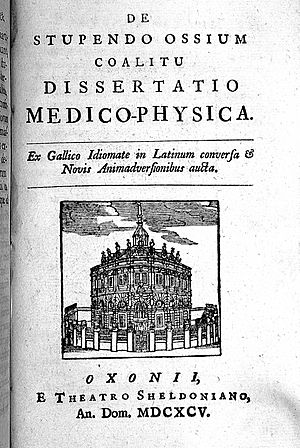Bernard Connor facts for kids
Bernard Connor (born around 1666 – died 1698) was a smart Irish doctor and historian. He was known for his medical skills and for writing a book about the history of Poland.
Contents
Life of a Traveling Doctor
Connor was born in County Kerry, Ireland, around 1666. He learned from private teachers at home. To become a doctor, he went to France in 1686. He studied at universities in Montpelier and Paris. He earned his medical degree in Reims on September 18, 1691. He became a very good doctor, studying the human body and chemistry.
Journey to Poland
Connor traveled with two sons of a Polish nobleman named Jan Wielopolski. He went with them through many European cities. They visited Venice, Padua, and passed through the Tyrol, Bavaria, and Austria. They then arrived in Vienna. After spending some time at the court of Leopold I, Holy Roman Emperor, they continued their journey. They traveled through Moravia and Silesia to Cracow and Warsaw in Poland.
Doctor to the King
In Poland, Bernard Connor became a doctor for King John III Sobieski. He became famous for correctly diagnosing the king's sister, Katarzyna Radziwiłłowa. Other doctors thought she had ague, which is a fever. But Connor figured out she had an abscess, which is a pocket of infection, in her liver.
Travels with a Princess
In 1694, Connor was chosen to travel with the king's only daughter. This was Princess Theresa Kunegunda Sobieska. She was going from Warsaw to Brussels to marry Maximilian II Emanuel, Elector of Bavaria. They started their journey on November 11, 1694. They arrived in Brussels on January 12, 1695.
Life in London
In February 1695, Connor moved to London, England. He lived in Bow Street, Covent Garden. He visited Oxford University and gave lectures there. He talked about new discoveries by famous scientists like Marcello Malpighi and Lorenzo Bellini. He returned to London in the summer of 1695. That winter, he gave more lectures. On November 27, 1695, he was chosen to be a fellow of the Royal Society. This is a very important group for scientists. In April 1696, he was allowed to practice medicine in London. He also gave lectures at Cambridge University that year.
His Final Days
Bernard Connor became sick with a fever. He passed away in October 1698. He was buried on October 30 at St. Giles's-in-the-Fields church. A priest named William Hayley gave a speech at his funeral.
Bernard Connor's Books
Bernard Connor wrote several important books during his life.
Medical Writings
In 1695, Connor published a book called Dissertationes Medico-Physicæ. This book had several medical papers inside it. They were about different topics like dangerous caves, the volcano Mount Vesuvius, and strange bone growths. One part of this book, De Stupendo Ossium Coalitu, described a condition where bones fuse together. This is now known as ankylosing spondylitis.
The History of Poland
The election of a new king in Poland made Connor write his most famous book. It was called The History of Poland. This book was written as letters to important people. It explained the old and new history of Poland. It was published in London in 1698 and had two volumes. Another scholar, John Savage, helped him write much of the second volume.
Evangelium Medici
In 1697, Connor published another interesting book. It was titled Evangelium Medici. In this book, he tried to explain how some miraculous cures mentioned in the Bible could be understood using natural science. This book caused a lot of discussion. Some people wondered about his religious beliefs because of it.
Other Works
Connor also wrote other scientific papers:
- Lettre écrite à Monsieur le Chevalier Guillaume de Waldegrave (1691): This letter described a human skeleton where many bones were joined together. Normally, these bones are separate.
- Zωοθανάσιον θαυμαστόν (1694): This paper was about a strange event. It discussed how living things died in a cave near Naples, Italy.



